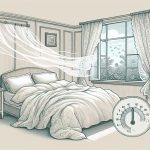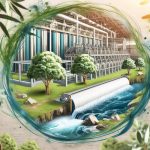Did you know that the fashion industry contributes over 92 million tons of waste each year? As you explore the domain of biodegradable fabrics, you’ll discover options like Tencel and organic cotton that not only reduce environmental impact but also offer unique performance features. Understanding these materials could reshape your choices in sustainable textiles, but what makes them truly stand out?
Table of Contents
Key Takeaways
- Tencel offers excellent moisture absorption and breathability, making it ideal for activewear and comfortable everyday clothing.
- Hemp fabric is durable and naturally resistant to mold, providing a long-lasting option with unique texture and strength.
- Biodegradable polyester breaks down rapidly under specific conditions while maintaining durability and moisture management, suitable for various applications.
- Organic cotton is soft, breathable, and biodegradable, ensuring comfort while minimizing environmental impact through sustainable farming practices.
- Mycelium-based fabrics, derived from mushrooms, exhibit unique textures and are lightweight, showcasing innovative potential in sustainable fashion.
Overview of Biodegradable Fabrics
Biodegradable fabrics, which are designed to break down naturally over time, offer a sustainable alternative to conventional textiles. These materials, often made from organic sources like cotton, hemp, or innovative biopolymers, decompose without leaving harmful residues.
You’ll find that they’re increasingly popular in various applications, from fashion to home goods, as consumers seek eco-friendly options. The production process typically involves fewer chemicals and less energy, making them a greener choice.
Additionally, biodegradable fabrics can mimic the look and feel of traditional textiles, ensuring you don’t have to compromise on quality or style. As you explore options, keep in mind that the environmental benefits of these fabrics contribute to a more sustainable future for our planet.
Advantages of Using Biodegradable Textiles
When you choose biodegradable textiles, you’re not just making a style statement; you’re also contributing to a healthier planet.
Choosing biodegradable textiles not only elevates your style but also fosters a healthier planet for future generations.
These fabrics decompose naturally, reducing landfill waste and pollution. By opting for biodegradable materials, you’re supporting sustainable practices that minimize environmental impact.
You’ll find that these textiles often use fewer chemicals in their production, promoting a safer ecosystem. Additionally, biodegradable fabrics can offer unique performance features, like breathability and moisture-wicking, enhancing your comfort.
They also align with your ethical values, appealing to consumers who prioritize sustainability. By wearing biodegradable textiles, you’re actively participating in the shift towards eco-friendly fashion, proving that style and environmental consciousness can go hand in hand.
Your choices today can lead to a better tomorrow for future generations.
Innovations in Biodegradable Fabrics
As the demand for sustainable fashion grows, innovative approaches to biodegradable fabrics are emerging, transforming the textile industry.
New materials like Tencel and hemp are gaining traction for their eco-friendly properties and unique textures. You’ll find companies experimenting with mycelium-based fabrics, harnessing the power of mushrooms to create durable textiles.
Additionally, breakthroughs in plant-based fibers, such as banana and pineapple leaves, are reshaping how you think about clothing production.
These innovations not only reduce environmental impact but also offer exciting styles and functionalities. You can expect to see more brands embracing these materials, appealing to conscious consumers who want to make responsible choices.
The future of fashion is here, and it’s biodegradable!
Features of Biodegradable Polyester
When you consider biodegradable polyester, you’ll notice its rapid degradation process, which sets it apart from traditional fabrics.
It also meets comparable durability standards, ensuring that it holds up well in everyday use.
Rapid Degradation Process
Although biodegradable polyester is designed for longevity in product use, its rapid degradation process sets it apart from traditional fabrics.
When exposed to specific environmental conditions, like moisture and heat, this material breaks down efficiently within a few months to a couple of years.
You’ll appreciate how it minimizes landfill waste while maintaining its functional qualities during its lifespan.
As it decomposes, biodegradable polyester releases fewer harmful chemicals compared to conventional materials, making it a more eco-friendly choice.
This unique feature allows you to enjoy performance without the guilt of long-lasting pollution.
By choosing biodegradable polyester, you’re not just opting for a fabric; you’re participating in a sustainable future.
It’s a win-win for you and the environment!
Comparable Durability Standards
Biodegradable polyester not only excels in its rapid degradation process but also meets comparable durability standards to traditional fabrics.
You’ll find that it offers impressive strength and resilience, making it suitable for various applications, from clothing to home textiles. This fabric can withstand daily wear and tear, providing longevity that rivals conventional polyester.
Additionally, it’s resistant to fading and stretching, ensuring your garments maintain their shape and color over time. Its moisture-wicking properties also enhance comfort, making it ideal for activewear.
By choosing biodegradable polyester, you’re not just opting for eco-friendliness; you’re also ensuring that your wardrobe remains functional and stylish without compromising on quality.
Environmental Impact Reduction
As you consider the shift towards sustainable fashion, you’ll find that biodegradable polyester markedly reduces environmental impact through its unique features.
This fabric breaks down naturally, minimizing landfill waste and pollution. Unlike traditional polyester, which lingers for centuries, biodegradable polyester decomposes within a few years, returning valuable nutrients to the soil.
Moreover, it’s often produced using renewable resources, lowering energy consumption and carbon emissions during manufacturing.
When you choose biodegradable polyester, you’re supporting eco-friendly practices that enhance soil health and promote biodiversity.
Plus, it maintains the durability and versatility you need, making it a smart choice for both clothing and home textiles.
Performance Characteristics of Biodegradable Fabrics
When you consider biodegradable fabrics, you’ll want to look at their moisture management properties, durability, and overall comfort.
These fabrics can offer a unique blend of performance characteristics that make them suitable for various applications.
Understanding how they handle moisture, wear, and softness can help you make informed choices for your wardrobe or projects.
Moisture Management Properties
Moisture management is essential for the performance of biodegradable fabrics, especially in applications where comfort and functionality matter. You want fabrics that can effectively wick away sweat and moisture, keeping you dry and comfortable throughout the day.
Biodegradable options, like organic cotton and Tencel, excel in moisture absorption while allowing breathability. These materials draw moisture away from your skin and facilitate evaporation, reducing that clammy feeling during physical activities.
Additionally, some of these fabrics come treated with natural finishes that enhance their moisture-wicking properties. This means you can enjoy sustainable choices without sacrificing performance.
When selecting biodegradable fabrics, look for those with excellent moisture management to guarantee you stay cool and comfortable while minimizing your environmental impact.
Durability and Longevity
Durability and longevity play crucial roles in the performance of biodegradable fabrics, especially for consumers seeking sustainable yet resilient options. You want fabrics that can withstand everyday wear while minimizing environmental impact.
Many biodegradable materials, like Tencel and organic cotton, offer impressive strength and resistance to deterioration. These fabrics can endure multiple washes and maintain their integrity, ensuring you get the most out of your investment.
Additionally, advancements in technology have led to the development of blends that enhance durability without compromising biodegradability. It’s important to choose fabrics that balance these qualities, so you don’t have to sacrifice longevity for sustainability.
Comfort and Softness
Selecting biodegradable fabrics doesn’t just involve considering durability; comfort and softness are equally important for a satisfying experience.
You’ll want materials that feel good against your skin, ensuring you can wear them all day without discomfort. Fabrics like Tencel and organic cotton offer a luxurious softness, while also being breathable and moisture-wicking. These features keep you comfortable in various conditions, whether you’re lounging at home or out and about.
Additionally, hemp isn’t only durable but becomes softer with each wash, making it a great choice for long-term wear.
When you prioritize comfort in biodegradable fabrics, you’re not just choosing eco-friendly options; you’re also enhancing your overall experience. Investing in these materials means you can feel good inside and out.
Sustainable Production Practices
As the demand for biodegradable fabrics grows, sustainable production practices become essential to minimize environmental impact.
You can contribute to a greener future by supporting brands that prioritize eco-friendly methods. Here are three key practices to look for:
- Natural Dyes: Brands using plant-based dyes reduce chemical runoff and promote healthier ecosystems.
- Water Conservation: Choose companies that implement water-efficient processes to lessen water waste during production.
- Renewable Energy: Opt for manufacturers that utilize renewable energy sources, like solar or wind, to power their facilities.
Market Potential for Biodegradable Materials
The rising demand for biodegradable fabrics signals a significant opportunity in the market for eco-friendly materials. Consumers are increasingly prioritizing sustainability, driving brands to seek alternatives to traditional textiles.
You’ll find that industries ranging from fashion to home goods are enthusiastic to adopt these innovative materials. Biodegradable fabrics not only minimize environmental impact but also attract eco-conscious consumers, boosting sales potential.
Additionally, as regulations around plastic and non-biodegradable products tighten, businesses that invest in biodegradable options can gain a competitive edge. With advancements in technology enhancing the performance of these materials, you can expect growth in this sector.
Challenges Facing Biodegradable Fabric Development
When it comes to developing biodegradable fabrics, you’ll face several challenges that can hinder progress.
Production scalability issues and mechanical strength limitations can make it tough to create fabrics that are both functional and eco-friendly.
Plus, cost and accessibility barriers often prevent widespread adoption, complicating efforts to make sustainable materials mainstream.
Production Scalability Issues
While the demand for biodegradable fabrics continues to rise, scaling up production presents significant challenges that must be addressed.
You’ll encounter issues that can hinder the growth of this sustainable sector. Here are three key challenges:
- Material Sourcing: Finding sufficient quantities of eco-friendly raw materials can be difficult, impacting production rates.
- Manufacturing Processes: Existing textile manufacturing techniques may not be compatible with biodegradable materials, requiring costly adaptations or new technologies.
- Cost Efficiency: Producing biodegradable fabrics often comes with higher costs compared to conventional fabrics, making it hard to compete in the market.
Mechanical Strength Limitations
Scaling up production isn’t the only hurdle in the development of biodegradable fabrics; mechanical strength limitations pose significant challenges as well.
You might find that many biodegradable materials lack the durability and resilience of traditional fabrics. This can lead to issues like tearing or fraying, especially under heavy use.
As a designer or manufacturer, you’ll need to evaluate how these weaknesses can affect the performance of your products. Testing different blends and treatments can help enhance strength, but it often complicates the biodegradability aspect.
Balancing mechanical integrity with environmental impact is a tricky tightrope to walk. Ultimately, you’ll need to innovate continually to create fabrics that meet consumer demands without sacrificing sustainability.
Cost and Accessibility Barriers
Though biodegradable fabrics offer promising environmental benefits, cost and accessibility barriers considerably hinder their widespread adoption. Many consumers and manufacturers find these fabrics pricier than conventional options, which can deter investment. Additionally, the limited availability of biodegradable materials makes it hard for you to source them consistently.
Here are three main challenges you might face:
- High Production Costs: The processes for creating biodegradable fabrics often involve more expensive materials and technology.
- Supply Chain Limitations: Many regions lack access to suppliers that specialize in these eco-friendly alternatives.
- Consumer Awareness: A lack of understanding about the benefits of biodegradable fabrics can lead to lower demand.
Overcoming these barriers is essential for promoting sustainable textile choices.
Future Directions for Biodegradable Textiles
As the demand for sustainable solutions grows, the future of biodegradable textiles promises exciting innovations that can reshape the fashion industry. You’ll see advances in fiber technology, utilizing natural materials like hemp and organic cotton, which enhance biodegradability. Integration of smart textiles can also revolutionize performance features, making them not only eco-friendly but functional in diverse applications.
| Innovation Type | Potential Benefits |
|---|---|
| Smart Textiles | Enhanced functionality |
| Bio-based Fibers | Reduced environmental impact |
| Waste Utilization | Circular fashion solutions |
| Eco-friendly Dyes | Lower toxicity in production |
These developments indicate a shift towards a greener future, and you can expect to encounter more brands prioritizing these sustainable practices.
Notable Brands Leading in Biodegradable Fabrics
While many brands are beginning to embrace sustainability, a few standout companies are leading the charge in biodegradable fabrics.
These innovators are transforming the textile industry by offering eco-friendly options without compromising quality or style. Here are three notable brands making waves:
- Patagonia – Known for its commitment to environmental responsibility, Patagonia utilizes organic cotton and recycled materials to create biodegradable products that align with their sustainability ethos.
- Eileen Fisher – This brand focuses on circular fashion, using natural fibers and processes that allow their garments to decompose at the end of their life cycle.
- Tentree – With a mission to plant ten trees for every item sold, Tentree integrates biodegradable fabrics into their collections, promoting a greener future.
These brands are paving the way for a more sustainable fashion industry.
Frequently Asked Questions
How Do Biodegradable Fabrics Compare to Traditional Fabrics in Comfort?
Imagine wrapping yourself in nature’s embrace. Biodegradable fabrics often feel softer against your skin, offering comfort while being environmentally friendly. Traditional fabrics might excel in durability, but you’ll find biodegradable options surprisingly cozy and breathable.
Are Biodegradable Fabrics Suitable for Outdoor Use?
Yes, biodegradable fabrics can be suitable for outdoor use. They often provide decent durability and comfort, but you’ll want to take into account factors like moisture resistance and UV protection to make sure they meet your specific needs.
What Certifications Should I Look for in Biodegradable Fabrics?
When choosing biodegradable fabrics, look for certifications like Global Organic Textile Standard (GOTS). For instance, a brand using GOTS-certified organic cotton guarantees both sustainability and safety, giving you confidence in your eco-friendly choices.
Can Biodegradable Fabrics Be Recycled After Use?
Biodegradable fabrics can’t typically be recycled in the traditional sense. Instead, they break down naturally over time. You should consider composting them or checking local programs that accept biodegradable materials for proper disposal and sustainability.
How Do I Care for Biodegradable Textiles to Ensure Longevity?
To care for biodegradable textiles, wash them gently in cold water, avoid harsh detergents, and air dry. This helps maintain their integrity, ensuring they last longer while remaining eco-friendly and reducing environmental impact.
- How to Get Oil-Based Paint Out of Wool - June 9, 2025
- Grass and Mud Combo Stains on Cotton Pants - June 9, 2025
- Dried Blood on a Denim Jacket, How to Clean - June 9, 2025







